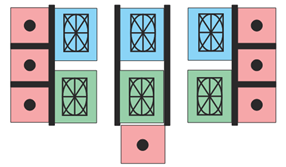Syllabic Structures Explanation
Explanation:
The provided image illustrates the three distinct syllabic structures within a hadokai tubatonona script. These structures are designed to represent syllables by combining consonants and vowels in a systematic way.
First Structure:
The first structure, shown on the left side of the image, features a 2×3 rectangle divided into two columns with a vertical line. The left column is further divided into three rows by horizontal lines from the outer edge on the left to the central vertical line, these are designated for the placement of vowels which are defined by the placement of a visible dot within the appropriate division. The column on the right is divided into two rows without a dividing line. The top row is for any letter that begins the syllable, and the bottom row is for any letter that ends the syllable. The sections are color-coded; the peach-colored areas are for the placement of the vowel dots. The Blue area is for the placement of the beginning consonant should there be one, and the green area is for the placement of the closing consonant should one be needed. This structure defines the vowels “a”, “e”, and “ʌ” as defined by the International Pronunciation Association (IPA)
![]() the “a” sound.
the “a” sound. ![]() the “e” sound.
the “e” sound. ![]() the “ʌ” sound
the “ʌ” sound




represents the syllable “les”
Second Structure:
The second structure, shown on the right side of the image, features a 2×3 rectangle divided into two columns with a vertical line. The right column is further divided into three rows by horizontal lines from the outer edge on the right to the central vertical line, these are designated for the placement of vowels which are defined by the placement of a visible dot within the appropriate division. The column on the left is divided into two rows without a dividing line. The top row is for any letter that begins the syllable, and the bottom row is for any letter that ends the syllable. The sections are color-coded; the peach-colored areas are for the placement of the vowel dots. The Blue area is for the placement of the beginning consonant should there be one, and the green area is for the placement of the closing consonant should one be needed, thus maintaining the same color coding as the first structure.
This structure defines the vowels “i”, “o”, and “ɪ” as defined by the IPA.
![]() the “i” sound.
the “i” sound. ![]() the “o” sound.
the “o” sound. ![]() the “ɪ” sound
the “ɪ” sound




represents the syllable “dok”
Third Structure:
The third structure, shown in the middle of the image, in keeping with the previous descriptions, the structure presents a 1×3 column, divided as before in the previous structures and bounded on either side with a vertical line each. These lines flank the consonant(s), dividing it as before into two rows, a top and a bottom. Again the beginning consonant goes in the top area and the closing consonant resides in the bottom area. which flank the consonants; however, the structure provides for a 3rd row under the main consonants for the placement of a vowel dot. This columnar design streamlines the syllable construction, focusing on vertical alignment.
This structure represents the u sound as defined by the IPA.





represents the syllable “put”
Word Structure:
When combining these into a word, they are written side by side.








is the word “david”
Sentence Structure:


























































This phrase reads “hadokai tubatonona tu balana aʤ” and this phrase translates into English as “I speak Tubatonona Language.”
